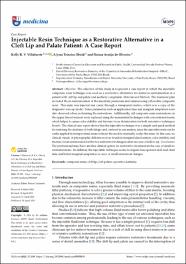Injectable Resin Technique as a Restorative Alternative in a Cleft Lip and Palate Patient: A Case Report

View/
Download
(application/pdf: 3.275Mb)
(application/pdf: 3.275Mb)
Date
2023-04-28Author(s)
Villafuerte, Kelly R. V.
eixeira Obeid, Alyssa T
de Oliveira, Naiara Araújo
Metadata
Show full item recordAbstract
Objective: The objective of this study is to present a case report in which the injectable composite resin technique was used as a restorative alternative for dental re-anatomization in a patient with cleft lip and palate and aesthetic complaints. Materials and Methods: The treatment plan included the re-anatomization of the maxillary premolars and canines using a flowable composite resin. This resin was injected and cured through a transparent matrix, which was a copy of the diagnostic wax-up model. Some parameters such as application time and marginal adaptation were also observed when performing the restorations. Additionally, old composite resin restorations on the upper lateral incisors were replaced using the incremental technique with conventional resins, which helped to assess color stability and fracture/wear deterioration for both restorative techniques. Results: The clinical case report shows that the injectable technique was a simple and quick method for restoring the anatomy of teeth (shape and contour) in one session, since the injectable resin can be easily applied in interproximal areas without the need to manually sculpt the resin. In this case, no clinical, visual, or photographic differences were found in marginal discoloration, color stability, and fracture/wear deterioration for the two restorative techniques after one year of follow-up. Conclusions: The professional may have another clinical option for restorative treatment in the case of small re-anatomizations. In addition, the injectable technique seems to require less operator skill and chair time and better marginal adaptation in cases of small anatomical changes.
Collections
- Web of Science (WOS) [236]

